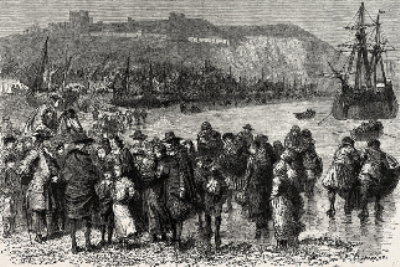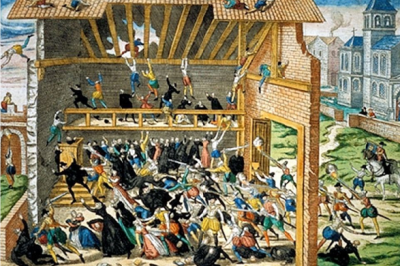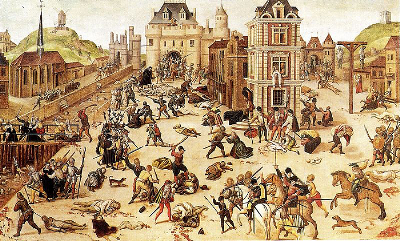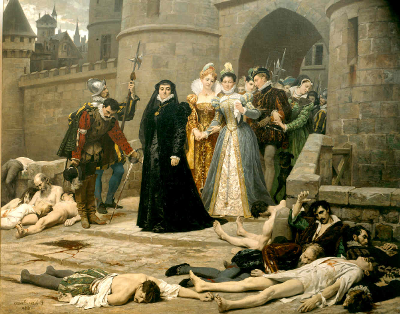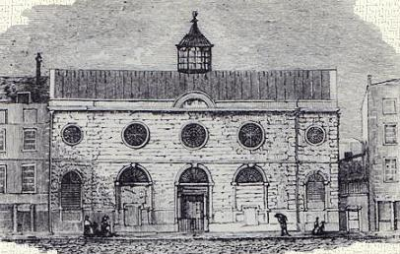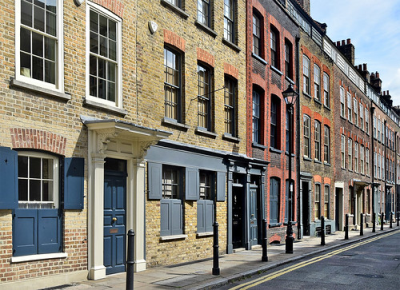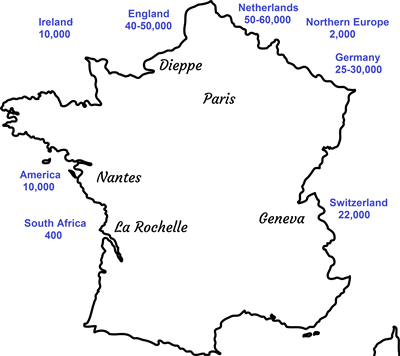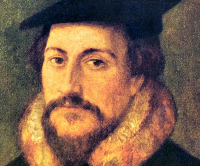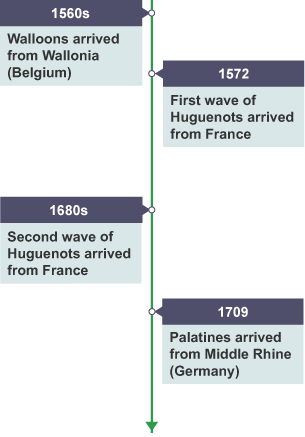Some of the images below have more information, click to open.
This is the second of my Potted Histories and I have chosen this subject as, although a lot has been written, I’m not sure that generally people know much about them, although they had a massive impact on this and other countries they migrated to, or ‘fled’ more accurately described their escape from France. Also a colleague at work, Alec Goulden, was a member of the Huguenot Society and always insisted that my name was a ‘Huguenot’ name and called me Monsieur Guinon with emphasis on the ‘on’.
Let me say right at the start my research has disproved my friend’s theory about Guinan being a Huguenot name as it appears that the name comes from the Irish surname O Cuanain and is derived from the Irish Cuinin for "rabbit", son of Dugal and originates as far back as the 13th century (pre-Huguenot). However, let’s not worry about that as it doesn’t take away the main thrust of this story which is to learn about the Huguenots, where they came from, what they did in life and how it relates to the modern perception of this group of people who ended up spread all over the world.
There would have been a good chance of my friend being right as it is estimated that as many as 1 in 6 of us are descended from the Huguenots. There are many well-known people throughout history who can claim to be descendants including Marlon Brando, Davy Crockett, Johnny Depp, Simon Le Bon (at least he sounds French), Howard Hughes, George S Patton, Churchill, Nigel Farage, Richie Benaud, Charlize Theron and many more (the list is endless). Princes William and Harry have Huguenot ancestors on both sides of their family including Gaspard de Coligny who was indirectly responsible for the migration that occurred after his death (see further below).
The Huguenots were THE original refugees to this country, and they did not come here in the back of a lorry or in a dinghy across the channel. The French used the word réfugié to describe the Huguenots leaving France which then became the English word refugee. They were in fact welcomed here as they came with many skills that were invaluable in those days such as silk weaving, jewellery and clock making and carpenters who made furniture. Over time the Huguenots assimilated into English society and as they drifted towards the Anglican Church names were anglicised, e.g. Ferret became Ferry, and Fouache became Fash and so on. More information on the Huguenots that came to England can be found in History Today.
They were French Protestants who lived mainly in the south and west of France and who followed the Swiss reformation of the Church led by John Calvin. Calvinism is based on a belief in salvation through individual faith without the need for the church. Bearing in mind that much of the wealth and therefore control of France in those days was held by the Catholic Church this new religion was considered dangerous and a threat to the accepted order and they were called heretics by the church. Their existence in a strongly catholic country like France in the 16th and 17th centuries was precarious to say the least. The popularity of the Huguenots was restricted mainly to many in the upper classes who did not like the power of the church.
In March, 1562 around 300 Huguenots holding religious services in a barn outside the town wall of VASSY, France, were attacked by troops under the command of Francis, Duke of Guise and more than 60 were killed and a 100 wounded. The massacre of Vassy, as it became known, ignited the Wars of Religion (1562-1598) that would rip apart, devastate and bankrupt France for the next three decades and cost the lives of 3 million people. Francis got his come-uppance in February 1563 when he was assassinated by a Huguenot during a siege on Orleans.
In August 1572 more than 8000 Huguenots were murdered during the infamous St Bartholomew Day Massacre on 23/24 August,1572. The massacre depicted in the painting (inset left) took place a few days after the wedding of Henry of Navarre, a Huguenot, to Marguerite de Valois (daughter of Catherine de Medici), a catholic, when thousands of Huguenots had arrived in Paris for the wedding celebrations. There are varying reports of exactly what happened and when, but Paris at the time was violently anti-Huguenot and this was not a popular wedding which gives some credibility to the wedding being the cause of it.
I prefer the Wikipedia report that puts the blame on an attempt to assassinate the Huguenot leader Admiral Gaspard de Coligny, who was in the city to attend the wedding. A few days after the wedding, he was shot and wounded as he walked home from a Protestant meeting and one of the suspects was Catherine de Medici (the king’s mother), who was concerned about his influence over her son Charles IX. Some have claimed that Coligny’s assassination had been planned years before by Catherine who was driven insane by maternal jealousy and was the signal for a premeditated programme of extermination of the Protestants. The story has it that after the assassination a group of Protestants burst in while she was eating dinner and threatened reprisals if nothing was done. It is believed that Catherine persuaded her weakling son to order the murder of the leading Protestant noblemen, to pre-empt any action by the Protestants, and that this task was given to mercenaries drawn from the Swiss Guard at the Vatican.
The exact chronology and details of the massacre are not fully understood and reports I have read vary in some of the detail, but the murder of Coligny and the Protestant noblemen by the mercenaries led to a wave of popular violence throughout Paris with the deaths of anything from a few thousands to tens of thousands of Huguenots. On the day after the murder of the noblemen it is said that Catherine personally walked through the streets of Paris (inset right) to inspect the carnage.
Henry of Navarre's life was spared when he pretended to support the Roman Catholic faith and history records that when the first rumours of the massacre reached the Vatican, Pope Gregory XIII was so jubilant that he wanted bonfires to be lit in Rome. Although he was persuaded to wait for the official communication, he then publically stated that - ‘The most Christian King might rid and purge his entire kingdom (of France) of the Huguenot plague’. Nothing would have pleased the Catholic Church more than the elimination of the Protestants.
Henry of Navarre succeeded Charles to the throne and as Henry IV signed the Edict of Nantes in April, 1598, that finally ended the Wars of Religion, and allowed the Huguenots some religious freedoms, including free exercise of their religion in 200 specified towns of France. Peace reigned, albeit uneasily, and during this period La Rochelle (a Protestant stronghold) was besieged (1625-27) and England failed to defeat the French at La Rochelle in a sea battle(1626). In October 1685 King Louis XIV revoked the Edict and introduced the ‘Dragonnades’ which involved billeting dragoons in Huguenot households and which led to violence and theft if the Protestants did not convert back to Catholicism.
This started a new age of persecution and resulted in hundreds of thousand Huguenots fleeing France for other countries. However, the Huguenots of France were in large part artisans, craftsmen, and professional people, and were usually well-received in the countries to which they fled for refuge. Public opinion in England, itself essentially a non-Catholic country, was outraged at the persecution of the Protestants who were offered sanctuary by Charles II. Charles II died in 1685 and his successor James II fortunately maintained the crown's welcome for the Huguenots. They arrived in London in great numbers and by 1710 it is estimated that as many as 50,000 Huguenots had settled here with at least half of them in and around Spitalfields in London. There were already some Huguenot settlements there where property was cheap and the markets were successful.
The Huguenots built many churches but there is only one remaining church, the French Protestant Church of London. The picture (left) shows the original church in Threadneedle St. which was demolished in 1888 and moved to Soho Gdns. By 1700 there were nine churches in Spitalfields whereas before they arrived there were none. Silk weaving, established by the first immigrants, was in great demand with the upper classes and thanks to their hard work and skill the textile trade thrived.
Spitalfields soon became known as 'Weaver Town' and workshop owners became wealthy with hundreds of employees. They built large houses in Spitalfields and some of these grand houses can still be seen in the conservation area of 'Fournier Street'. The house illustrated (right) is known as the Pink House and belonged to a silk weaver. Many of the Huguenots moved out of London to the suburbs as silk weaving became less popular, but their influence is still there in the street names, e.g. Navarre, Montclare, Fournier, Ligonier, etc., and it is estimated that Huguenot blood runs through a quarter of the population of London.
In the early migration, most Huguenots went initially to Germany, the Netherlands and England, although many found their way eventually to places as remote as South Africa and British North America (as it was then), especially to the Carolinas, Virginia, Pennsylvania and New York. The migration map (inset left) gives a rough idea of where around 180,000 Huguenots migrated to in Europe and beyond. Their character and talents in the arts, sciences, and industry were such that they are generally felt to have been a substantial loss to the French society. There are active Huguenot Societies in Europe, all over America, in the UK and South Africa. Those in America are especially active.
![]()
It is not surprising that a large number went to Switzerland and Germany as they were followers of John Calvin, who lived in Geneva and led the Protestant revolution throughout Europe. At the time, Geneva was renowned for their jewellery making but Calvin was a proponent of austerity and the city banned people from wearing jewellery. The goldsmiths and jewellery makers turned to watchmaking to keep their businesses going and this made Geneva an ideal place for the Huguenots to settle as they were both Protestants and also very skilled in clock and watchmaking. It is also a fundamental reason why Swiss clocks and watches are so highly regarded around the world for their reliability and quality. Cartier, Faberge, Tissot are just a few of the watchmakers who can trace their ancestry to the Huguenots.
Outside of Europe Huguenots started their migration to North America well before the Edict of Nantes. Around 1624, the first group of Huguenots arrived in the Dutch colony of ‘New Amsterdam’, settling on what is now Long Island and later on nearby Staten Island. Around 50 years later the next influx came and many settled in the New York area creating the settlement of New Paltz. The Huguenots from Belgium who settled here were often referred to, incorrectly, as Walloons because they had originally come from the area in southern Belgium, known as Wallonia. However, they were originally from France but over time had integrated into Belgium society.
The Huguenots settled mainly along the eastern coast of North America and became farmers, labourers, ministers, soldiers, sailors and government officials. George Washington, himself, was the grandson of a Huguenot on his mother’s side and there are many renowned descendants of Huguenots in all walks of life throughout America, and in fact the world, today.
When the second wave arrived in the 1680’s Charles II granted them ‘denization’, which was a document signed by the king granting nationalisation and citizen rights to foreigners, and was granted mainly because they were the enemies of our enemies, France, and therefore our friends. Denization no longer exists in English law. On top of this as already discussed they were not Catholic and also brought much-needed skills and wealth that helped to boost England’s economy.
It’s perhaps important to mention that whereas all Huguenots were Protestant, not all Protestants were Huguenot. This was clear when a group of Protestants from the Rhineland (the Palatines) came to England in 1709, they were not Huguenot and some were not even Protestant. When this became apparent sympathy for them waned, many returned home, a few stayed, some managed to go to America but around 3000 were sent to Ireland as a cheap option to get rid of them. For those 3000 it was a disaster as they were hated by local Catholics who were suffering under English rule. They could not apply their farming skills in a different environment and were as poor as they had been in Germany. Only a few stayed in Ireland, the rest either returned to England or left for America.
So what impact did the Huguenots have on England that we see in our world today? The BBC run a bitesize online learning series that has some interesting information on this subject. The Huguenots had a huge impact on the economy of Britain. They revitalised the silk weaving trade and various manufacturing industries such as cutlery making in Sheffield as well as investing heavily in growing businesses. Huguenots were key investors in the Bank of England and its first Governor was descended from Huguenot immigrants; they were at the heart of the growth of capitalism as we know it today. The establishment of the National Debt by the bank at the time meant that the government could borrow money to build ships to protect the slave trade and the plantation system and finance the growth of the British Empire. So for all you woke generation out there the slave trade was all down to the Huguenots from France.
Interestingly, the Walloons, Huguenots and Jews were all allowed to have their own place of worship, a right denied to others in society, in an attempt to make us more open to religious differences. It could be argued that the reason we are probably more tolerant of other religious and minority groups in this country than some is an indirect result of the arrival of the Huguenots over 300 years ago.
French Protestants, as the Huguenots are more commonly known, were and still are in a minority in France. Remnants of Huguenot culture, including French Protestant churches, French names of towns and streets as well as textile and winemaking traditions, endure as reminders of the Huguenot’s global influence.
References
WikipediaThe Huguenot Society of Gt Britain & Ireland
History Today
Encyclopaedia Britannica
The Huguenots of Spitalfields
The Name Guinan
As a postscript to the short account of the Huguenots, having been disappointed to learn that my name is not a Huguenot name I endeavoured to determine its true history.
It is derived from the old Gaelic name O'Cuinneain. The Gaelic prefix "O" indicates "male descendant of", plus the personal name Cuinneain means "hero" or "warrior" (appropriate!!). The name is particularly widespread in Munster, especially in North Tipperary, West Clare and North Limerick. It has four spelling variations: Guinan, Guinane and Ginnnane. So now you know!
Guinan is a rare surname with only around 1 in 100,000 living now; mind you with 3 children and 7 grandchildren all with my surname, I’m doing my best to reduce the odds.
I searched for famous ‘Guinans’ but didn’t come up with much.
There was a famous hostess of the prohibition-era speakeasies called Mary ‘Texas’ Guinan, a former cowboy and movie actress who moved to New York to open the 300 Club in 1920. Guinan would be mistress of ceremonies in a series of illegal nightclubs in the city that were celebrity hangouts but often had to move to new locations after raids by authorities. Her trademark line was “Hello, suckers!”
There was of course Guinan in Star Trek, played by Whoopi Goldberg, who for all you Trekki fans was the enigmatic bartender who ran Ten Forward, the lounge aboard the USS Enterprise-D. She was well known for her wise counsel, which proved invaluable many times and was an El-Aurian, a race of "listeners" who were scattered by the Borg. In fact the producers came up with the name Guinan from Texas Guinan who ran the speakeasies above.
Who could forget Steve Guinan, that well known footballer who played for such top teams as Plymouth Argyle, Scunthorpe United, Cambridge United, Shrewsbury Town and Hereford United. He now works for the FA.
Then there was Mary Guinan Ph.D., M.D. known informally as Dr Condom. She is the dean at the School of Community Health Sciences at the University of Nevada and is known for her work in the initial investigation of the HIV/AIDS epidemic for the Centres for Disease Control and Prevention, hence the ‘condom’ nickname.
Perhaps I’ve modelled myself on Fr. Michael Guinan who received his PhD in Semitic Languages & Literatures from the Catholic University of America in 1972 and has taught for more than 40 years at the Franciscan School of Theology. This may explain why I read the bible when I go to bed every night.
I know they say that we are all only 6 degrees of separation from each other but I'm pretty sure I'm not related to any of the above especially Guinan from Star-Trek (lol).
Shown below left to right: Texas Guinan, Guinan (Star Trek), Steve Guinan, Mary Guinan, Fr. Michael Guinan


